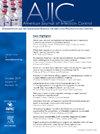Unseen threats: Lumens 2.0 study reveals the hidden challenges of cleaning lumened surgical instruments
IF 3.8
3区 医学
Q2 INFECTIOUS DISEASES
引用次数: 0
Abstract
Background
Surgical site infections can cause significant morbidity requiring lengthy antimicrobial treatment. Infections have been linked to surgical instruments with retained tissue and foreign debris, as the presence of blood or soil interferes with sterilization effectiveness. This study aimed to determine the prevalence of visible soil or debris inside instruments and evaluate the impact of recleaning efforts.
Methods
Borescopes were used to inspect lumens of instruments used for orthopedic, neurologic, or ear-nose-throat procedures. Whenever visible soil or debris was observed, the instrument was recleaned up to 3 times and reinspected to assess the impact of additional cleaning.
Results
Researchers performed 117 inspections (40 unique instruments, 77 reinspections). All instruments had complex lumens that impede access by brushes. Debris and discoloration or residues were observed inside 100% of instruments, with rusty patches in 95%. Some soil was removed by recleaning, but visible soil remained in most lumens and fragments of lint or brush bristles were visible upon repeat inspection.
Conclusions
Cleaning in accordance with the manufacturer’s instructions was not effective for lumened surgical instruments. Solutions will require collaboration between infection prevention, sterile processing, and manufacturers to evaluate risk and develop strategies for improving processing outcomes.
看不见的威胁:流明2.0研究揭示了清洁流明手术器械的隐藏挑战。
背景:手术部位感染可引起严重的发病率,需要长时间的抗菌治疗。感染与手术器械残留的组织和异物有关,因为血液或土壤的存在会干扰消毒效果。本研究旨在确定仪器内可见土壤或碎片的流行程度,并评估清理工作的影响。方法:使用管道镜检查骨科、神经科或耳鼻喉科手术所用器械的管腔。每当观察到可见的土壤或碎片时,仪器最多清理三次,并重新检查以评估额外清洁的影响。结果:研究人员进行了117次检查(40种独特的仪器;77复检)。所有的仪器都有复杂的管腔,阻碍了刷子的接触。在100%的仪器内观察到碎片、变色或残留物,95%的仪器内有生锈的斑块。一些土壤通过清洗被清除,但可见的土壤仍留在大多数腔内,并且在重复检查时可以看到绒毛或刷毛的碎片。讨论/结论:按照制造商的说明进行清洗对管腔手术器械无效。解决方案将需要感染预防、无菌加工和制造商之间的合作,以评估风险并制定改善加工结果的战略。
本文章由计算机程序翻译,如有差异,请以英文原文为准。
求助全文
约1分钟内获得全文
求助全文
来源期刊
CiteScore
7.40
自引率
4.10%
发文量
479
审稿时长
24 days
期刊介绍:
AJIC covers key topics and issues in infection control and epidemiology. Infection control professionals, including physicians, nurses, and epidemiologists, rely on AJIC for peer-reviewed articles covering clinical topics as well as original research. As the official publication of the Association for Professionals in Infection Control and Epidemiology (APIC)

 求助内容:
求助内容: 应助结果提醒方式:
应助结果提醒方式:


